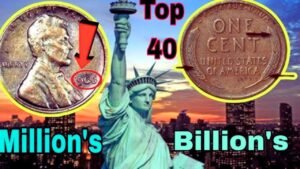The Lincoln Wheat Penny is more than just a coin. It’s a piece of American history that could be hiding in your pocket. With some rare versions rumored to be worth billions, let’s explore why this penny is a collector’s dream and how you might spot one.
What Is the Lincoln Wheat Penny?
The Lincoln Wheat Penny was first minted in 1909 to celebrate Abraham Lincoln’s 100th birthday. It replaced the Indian Head cent and was the first U.S. coin to feature a real person. Its iconic design—Lincoln’s portrait on the obverse and wheat stalks on the reverse—symbolizes America’s growth and resilience.
A Historic Design
Designed by Victor David Brenner, the penny’s detailed portrait and wheat stalks captured the era’s spirit. Early versions, like the 1909-S VDB, carried the designer’s initials, making them instantly collectible. Over time, the design evolved, but its legacy endures.
Years of Production
The Wheat Penny was minted from 1909 to 1958. In 1959, the reverse changed to the Lincoln Memorial design. This long production run created many variations, some of which are incredibly rare.
Why Are Some Wheat Pennies So Valuable?
Not every Wheat Penny is worth a fortune, but certain factors make specific coins priceless. Rarity, minting errors, and condition drive their value sky-high. Let’s break down what makes these pennies special.
Rare Dates and Mint Marks
Some years and mint marks are exceptionally scarce. For example:
- 1909-S VDB: Only 484,000 were minted, and the designer’s initials (VDB) make it a collector’s gem.
- 1914-D: Just 1.2 million were produced, and high-grade versions fetch millions.
- 1943 Copper Penny: Most 1943 pennies were steel due to wartime copper shortages, but a few copper ones slipped through, making them ultra-rare.
Minting Errors
Errors like double-die strikes (where the design is stamped twice) or off-center strikes add value. These mistakes create unique coins that collectors crave. For instance, the 1955 Double Die penny is famous for its blurry text and can sell for thousands.
Condition Matters
A penny’s condition, graded on a scale from Poor to Mint State (MS-70), impacts its worth. A well-preserved 1909-S VDB in MS-65 condition could fetch over $100,000, while a worn one might be worth $1,000.
| Year/Mint Mark | Estimated Value (High Grade) | Rarity Factor |
|---|---|---|
| 1909-S VDB | $100,000–$2 million | Low mintage, designer initials |
| 1914-D | $50,000–$500,000 | Limited production |
| 1943 Copper | $1 million–$10 million | Extreme rarity due to error |
The $4 Billion Rumor: Fact or Fiction?
Talk of a Lincoln Wheat Penny worth $4 billion grabs headlines, but is it real? The figure likely stems from speculation about ultra-rare coins like the 1943 copper penny. While no penny has sold for billions, top specimens have fetched millions at auctions. For example, a 1943 copper penny sold for $1.7 million in 2010. The “billion-dollar” hype reflects the coin’s rarity and collector frenzy.
Why Such High Values?
Collectors pay premium prices for coins with historical significance and scarcity. A single coin in pristine condition, with a unique error or mint mark, can spark bidding wars. The dream of finding one fuels the excitement.
Could You Find a Valuable Wheat Penny in Circulation?
Believe it or not, Wheat Pennies still turn up in circulation. Old coin rolls, family heirlooms, or forgotten jars might hold a treasure. While the odds of finding a $1 million penny are slim, it’s not impossible.
Where to Look
- Coin Rolls: Banks sometimes distribute rolls with older coins.
- Estate Sales: Check coin collections at auctions or garage sales.
- Change Jars: Old pennies often end up in household stashes.
Tips for Spotting a Valuable Penny
- Check the Date and Mint Mark: Look for 1909-S VDB, 1914-D, or 1943 copper.
- Inspect for Errors: Double-die or off-center strikes are telltale signs.
- Examine Condition: Shiny, uncirculated coins are worth more.
- Use a Magnifying Glass: Small details like mint marks (S, D, or none) matter.
Why Most People Miss These Treasures
Wheat Pennies blend in with everyday change. To the untrained eye, they’re just old cents. Many valuable coins have been spent, lost, or ignored because people didn’t know their worth. Education is key to spotting these hidden gems.
Common Mistakes
- Ignoring Old Coins: People assume old pennies are worthless.
- Not Checking Mint Marks: The tiny “S” or “D” can mean millions.
- Poor Storage: Damaging coins lowers their value.
The Cultural Legacy of the Wheat Penny
Beyond its value, the Wheat Penny is a symbol of American history. It honors Lincoln, a revered figure, and reflects the nation’s agricultural roots. For collectors, it’s a reminder that treasures can hide in plain sight.
A Collector’s Passion
Coin collecting, or numismatics, is about more than money. It’s about preserving history, chasing rarity, and sharing stories. The Wheat Penny embodies this passion, connecting generations through a simple cent.
How to Start Collecting Wheat Pennies
Ready to hunt for your own treasure? Here’s how to begin:
- Learn the Basics: Study key dates, mint marks, and errors.
- Get Tools: A magnifying glass and coin guidebook are essential.
- Join a Community: Connect with local coin clubs or online forums.
- Visit Coin Shows: Find dealers and appraisers for expert advice.
- Store Safely: Use acid-free holders to protect your coins.
Frequently Asked Questions
Q1: What years should I look for in Wheat Pennies?
Focus on 1909-S VDB, 1914-D, and 1943 copper pennies. These are the rarest and most valuable.
Q2: How can I tell if my penny is a rare 1943 copper?
Check if it’s copper, not steel. A magnet won’t stick to copper. If you suspect it’s rare, get it appraised by a professional.
Q3: Are all Wheat Pennies valuable?
No, most are worth a few cents to a few dollars. Only specific dates, mint marks, or errors fetch high prices.
Q4: Where can I get my Wheat Penny appraised?
Visit a reputable coin dealer or contact the Professional Coin Grading Service (PCGS) or Numismatic Guaranty Corporation (NGC).
Q5: Can I still find Wheat Pennies in my change?
Yes, though rare. Check coin rolls, old jars, or inherited collections for hidden treasures.
Conclusion: Start Your Treasure Hunt Today
The Lincoln Wheat Penny is more than a coin—it’s a piece of history with the potential for incredible value. Whether you’re a collector or just curious, checking your change could lead to a life-changing discovery. Grab a magnifying glass, learn the key dates, and start hunting. Who knows? Your next penny might be worth millions.




